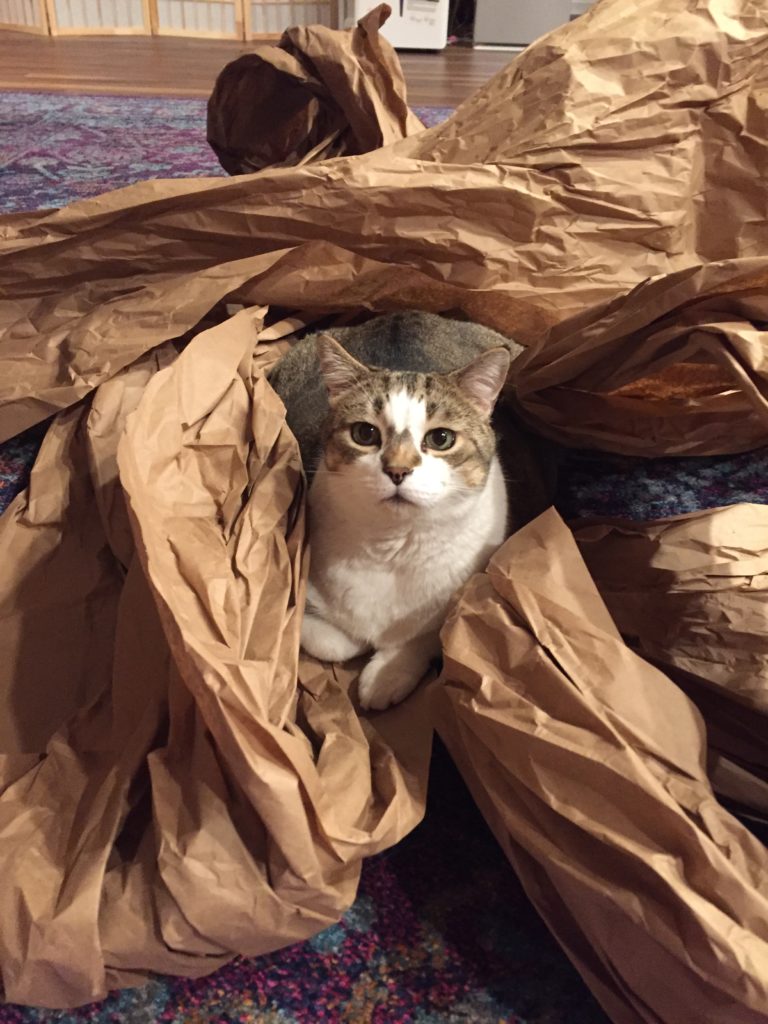


Hi, everyone. This is my first blog post ever! I’m so excited! I’d like to talk to you about playing with your cat. While cats do often play with toys by themselves and can even turn miscellaneous objects into toys (plastic milk jug rings and lids, pipe cleaners, and hair ties, for example) there are several good reasons for you to play interactively with your cat. First of all, if you do it right, it improves your cat’s mental, emotional, and physical health. Paying attention to the direction and speed of the toy as it moves through the air, across the ground, or over furniture so that she can plan her attack keeps your cat’s mind sharp. The toy’s sound–a crinkle, a jingle, a flutter, a rasp–and its smell (perhaps catnip, treats, or an appropriate essential oil) provide sensory stimulation and pique your cat’s interest, and the feel of the toy in her paws and teeth once she has caught it is so satisfying. Playing engages her predatory instincts, which helps your cat remember her purpose and improves her self-confidence. The running, jumping, and diving your cat does when playing burns calories, too, and helps to maintain her muscle tone. Put simply, playing helps keep your cat healthy. Another benefit is that playing with your cat can have a big impact on her behavior as well. Oftentimes, cats become destructive because they are bored or feel neglected. Playing interactively with your cat fifteen to thirty minutes a day will help her release pent-up energy as she tears up toys and will take her mind off of your couch or curtains or other possessions. It will also improve your emotional bond with her because she’ll feel loved as you spend time focused on her. The improved self-confidence that interactive play can engender can also change the dynamics between multiple cats in a household. When timid cats gain self-confidence through play, aggressive cats find them less interesting to harass. The cool thing is that playing with your cat is beneficial to you as well! In addition to forcing you to exercise your own body a bit, it helps you lighten up and forget about your concerns for a little while, all of which helps manage your stress level. It’s a win-win situation.
I believe we’ve established that playing with your cat is important. HOW you play with your cat is important, too. When you play with your cat, it should enable your cat to mimic the hunting she would do if on her own in the outdoors. The kind of toy you use will have an impact on the way you should move it. For interactive play, it is best to use a toy attached to a string that is tied to a long handle. You want the string to be long enough so that your cat is not distracted by your hand as you move the toy around. She should notice only the toy. If your toy is long and slinky, pretend it’s a snake and move it around accordingly; make it slither in a sort of serpentine pattern and make it stop amidst items lying on the floor. Think of a snake slithering along and then stopping to rest nestled into or on top of some rocks. If the toy’s a mouse, make it move along the edges of carpet and around furniture legs. Mice try not to run across the middle of open fields where a predator can see them with ease. I usually make mouse toys alternate between running and hiding. Real mice are good jumpers, so your mouse toy can jump over things and up onto things as well. If you have a bird-type toy, keep it in the air a good bit of the time and get your cat leaping. After your cat has been active for about twenty minutes, make the toy prey slow down for a few minutes and then seem injured so that your cat can have the satisfaction of “killing” it. There are a couple of things to keep in mind about your cat when you play with her. Her vision is not very good up close. She can, however, detect movement well, so she can see the toy more easily when it is on the move than she can if it is sitting still. Cats use their hearing and sense of smell to help them pinpoint prey in the wild, so enhancing the toy with something that makes noise or produces an odor is helpful. Don’t forget that cats are ambush hunters. If your cat doesn’t try to chase the toy when you first start playing, don’t give up! She’s just waiting for the perfect moment to pounce. Keep moving the toy prey around, and she’ll eventually go for it. Finally, move the toy prey across in front of your cat or away from her, not toward her. No mouse, bird, snake, or bunny in its right mind would run toward a cat, and it would certainly not jump on her.
If I can figure out how to do it, I’ll post some videos of me demonstrating how to make simple and cheap toys you can use when playing with your cat. I’ll try to post some video clips of me playing with my clients’ cats as well in order to demonstrate some of the concepts above. In the meantime, I hope you’ve found this article helpful. Enjoy playing with your cat!
